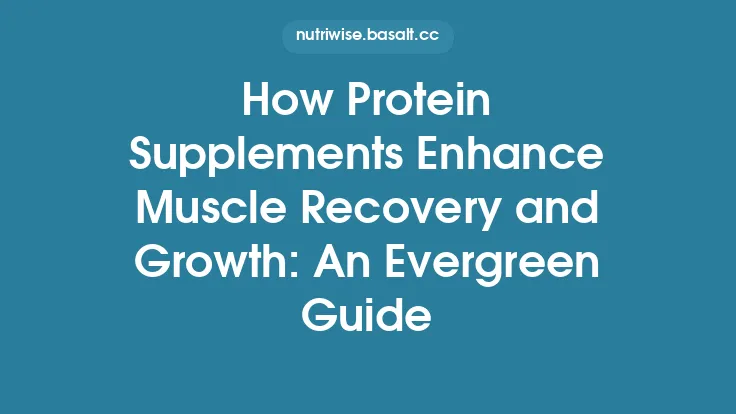The human immune system is a complex network of cells, tissues, and signaling molecules that work together to defend the body against pathogens, toxins, and abnormal cells. While a balanced diet, regular physical activity, adequate sleep, and stress management form the foundation of a robust immune response, many people turn to dietary supplements to fill nutritional gaps or to provide an extra “boost.” In recent years, a growing body of research has clarified which ingredients have genuine immunomodulatory potential, how they act at the molecular level, and what dosage ranges are supported by clinical evidence. This article reviews the most well‑studied immunity‑boosting supplements, explains the mechanisms by which they influence immune function, and offers practical guidance for selecting and using these products safely.
The Science of Immune Modulation: Key Pathways Targeted by Supplements
Understanding how a supplement can affect immunity requires a brief look at the underlying biology. The immune system can be broadly divided into innate and adaptive components:
- Innate immunity provides the first line of defense through physical barriers (skin, mucosa), phagocytic cells (macrophages, neutrophils), natural killer (NK) cells, and soluble factors such as complement proteins and cytokines.
- Adaptive immunity involves highly specific T‑cell and B‑cell responses, leading to immunological memory and the production of antibodies.
Most dietary supplements aim to support one or more of the following processes:
- Enhancement of barrier integrity – strengthening skin and mucosal surfaces to prevent pathogen entry.
- Optimization of phagocyte function – improving the ability of macrophages and neutrophils to engulf and destroy microbes.
- Modulation of cytokine production – balancing pro‑inflammatory (e.g., IL‑6, TNF‑α) and anti‑inflammatory (e.g., IL‑10) signals to avoid chronic inflammation while still mounting an effective response.
- Support of lymphocyte proliferation and differentiation – ensuring adequate numbers of functional T‑cells and B‑cells.
- Antioxidant protection – reducing oxidative stress that can impair immune cell signaling and cause tissue damage.
Supplements that have demonstrated activity in these pathways are discussed below.
Vitamin C (Ascorbic Acid)
Evidence Base
Vitamin C is perhaps the most iconic immune‑support nutrient. Randomized controlled trials (RCTs) have shown that regular supplementation (≥200 mg/day) can modestly reduce the duration of common cold symptoms by about 8 % and may lower the incidence of colds in individuals under heavy physical stress (e.g., marathon runners, soldiers).
Mechanisms of Action
- Collagen synthesis – Vitamin C is essential for the hydroxylation of proline and lysine residues in collagen, reinforcing epithelial barriers in the skin and respiratory tract.
- Phagocyte function – It accumulates in neutrophils, where it enhances chemotaxis, oxidative burst, and microbial killing.
- Antioxidant capacity – By scavenging reactive oxygen species (ROS), vitamin C protects immune cells from oxidative damage during the inflammatory response.
- Lymphocyte proliferation – In vitro studies demonstrate that vitamin C supports the proliferation of T‑cells and the production of interferon‑γ (IFN‑γ), a key antiviral cytokine.
Practical Recommendations
- Dosage – 200–500 mg taken 1–2 times daily. Higher doses (up to 2 g) are generally safe but may cause gastrointestinal upset.
- Formulation – Ascorbic acid, sodium ascorbate, or mineral ascorbates (e.g., calcium ascorbate) are all bioavailable. Liposomal vitamin C may improve absorption for very high doses.
- Timing – Split dosing throughout the day maintains plasma concentrations, as vitamin C is water‑soluble and excess is excreted in urine.
Vitamin D (Calciferol)
Evidence Base
Vitamin D deficiency (serum 25‑hydroxyvitamin D <20 ng/mL) is associated with increased susceptibility to respiratory infections. Meta‑analyses of RCTs indicate that daily supplementation of 1,000–2,000 IU reduces the risk of acute respiratory tract infections, particularly in individuals with baseline deficiency.
Mechanisms of Action
- Innate immunity – The active hormone 1,25‑dihydroxyvitamin D binds to the vitamin D receptor (VDR) on macrophages and dendritic cells, upregulating the expression of antimicrobial peptides such as cathelicidin (LL‑37) and defensins.
- Adaptive immunity – Vitamin D modulates T‑cell differentiation, suppressing Th1‑mediated pro‑inflammatory responses while promoting regulatory T‑cells (Tregs) that help prevent excessive inflammation.
- Barrier function – It enhances tight‑junction protein expression in epithelial cells, strengthening mucosal barriers.
Practical Recommendations
- Dosage – 1,000–2,000 IU/day for most adults; higher doses (up to 4,000 IU) may be needed to correct deficiency, guided by serum testing.
- Formulation – Cholecalciferol (vitamin D₃) is preferred over ergocalciferol (vitamin D₂) due to superior bioavailability.
- Safety – Chronic intake >10,000 IU/day can lead to hypercalcemia; routine monitoring is advisable for high‑dose regimens.
Zinc
Evidence Base
Zinc is a trace mineral essential for immune competence. Systematic reviews of RCTs show that zinc lozenges (15–30 mg elemental zinc) taken within 24 hours of cold onset can reduce symptom severity and duration by up to 40 %. Prophylactic supplementation (≈10 mg/day) modestly lowers the incidence of infections in children and the elderly.
Mechanisms of Action
- Enzymatic cofactor – Zinc is required for over 300 enzymes, many of which are involved in DNA replication, RNA transcription, and cell division, directly influencing lymphocyte proliferation.
- Barrier integrity – It stabilizes cell membranes and supports the production of keratin, a structural protein in skin and mucosal surfaces.
- Antiviral activity – Zinc can inhibit the replication of certain viruses (e.g., rhinovirus, coronaviruses) by interfering with viral polymerase activity.
- Cytokine regulation – Adequate zinc levels favor a balanced cytokine profile, reducing excessive pro‑inflammatory signaling.
Practical Recommendations
- Dosage – 15–30 mg elemental zinc per day for short‑term therapeutic use; 10 mg/day for maintenance. Avoid chronic intake >40 mg due to risk of copper deficiency.
- Formulation – Zinc gluconate, zinc acetate, and zinc picolinate have good bioavailability. Zinc lozenges are specifically formulated for rapid oropharyngeal delivery.
- Timing – Take with food to minimize gastric irritation, but avoid high‑phytate meals that can impair absorption.
Selenium
Evidence Base
Selenium, incorporated into selenoproteins such as glutathione peroxidases and thioredoxin reductases, has been linked to enhanced antiviral immunity. A large RCT in elderly participants demonstrated that supplementation with 200 µg selenium per day reduced the incidence of influenza‑like illness by 30 % compared with placebo.
Mechanisms of Action
- Antioxidant defense – Selenoproteins neutralize hydrogen peroxide and lipid hydroperoxides, protecting immune cells from oxidative stress during infection.
- Thyroid hormone metabolism – Selenium is required for the conversion of thyroxine (T₄) to the active triiodothyronine (T₃), which influences immune cell metabolism.
- Viral replication inhibition – Certain selenoproteins can interfere with viral genome replication and protein synthesis.
Practical Recommendations
- Dosage – 100–200 µg/day, not exceeding the tolerable upper intake level of 400 µg/day.
- Formulation – Selenomethionine is the most bioavailable organic form; sodium selenite is an inorganic alternative but may be less well tolerated.
- Safety – Chronic excess can cause selenosis (hair loss, nail brittleness, neurological symptoms); periodic monitoring is prudent for high‑dose regimens.
Probiotics
Evidence Base
The gut-associated lymphoid tissue (GALT) houses a substantial proportion of the body’s immune cells. Clinical trials have shown that specific probiotic strains (e.g., *Lactobacillus rhamnosus GG, Bifidobacterium lactis* BB‑12) can reduce the risk of upper respiratory infections by 20–30 % and shorten illness duration.
Mechanisms of Action
- Microbiota modulation – Probiotics compete with pathogenic bacteria for adhesion sites and nutrients, limiting colonization.
- Mucosal immunity – They stimulate the production of secretory IgA, a key antibody that neutralizes pathogens at mucosal surfaces.
- Cytokine balance – Certain strains promote anti‑inflammatory cytokines (IL‑10) while dampening pro‑inflammatory mediators.
- Barrier reinforcement – Short‑chain fatty acids (SCFAs) produced by probiotic fermentation strengthen tight junctions in the intestinal epithelium.
Practical Recommendations
- Dosage – 1–10 billion CFU (colony‑forming units) per day for general immune support; higher doses (≥10 billion CFU) may be needed for therapeutic effects.
- Strain specificity – Look for products that list the exact strains and their CFU counts; multi‑strain blends can be beneficial but must be evidence‑based.
- Stability – Choose formulations with proven shelf‑life stability (e.g., freeze‑dried capsules) and store according to manufacturer instructions.
Elderberry (Sambucus nigra) Extract
Evidence Base
Elderberry has a long tradition in folk medicine for treating colds and flu. A meta‑analysis of 7 RCTs found that standardized elderberry extracts (300–600 mg of anthocyanins per day) reduced the duration of influenza symptoms by an average of 4 days and decreased the need for over‑the‑counter medications.
Mechanisms of Action
- Flavonoid activity – Anthocyanins and other polyphenols exhibit antiviral properties by blocking viral entry and replication.
- Immune stimulation – Elderberry can increase the production of cytokines such as IL‑1β, IL‑6, and TNF‑α, enhancing the early innate response.
- Antioxidant effects – The high antioxidant capacity mitigates oxidative stress associated with viral infections.
Practical Recommendations
- Dosage – 300–600 mg of standardized extract (containing 30–45 % anthocyanins) taken 2–3 times daily at the first sign of illness.
- Formulation – Capsules, syrups, or lozenges; ensure the product is free of added sugars if used for therapeutic purposes.
- Cautions – Not recommended for individuals with autoimmune disorders without physician guidance, as immune stimulation could theoretically exacerbate disease activity.
Beta‑Glucans (Mushroom‑Derived)
Evidence Base
Beta‑glucans are soluble fibers derived from the cell walls of fungi (e.g., *Saccharomyces cerevisiae, Lentinula edodes*). Clinical data indicate that daily intake of 250–500 mg of purified beta‑glucan can enhance vaccine response (higher antibody titers) and reduce the incidence of common infections in healthy adults.
Mechanisms of Action
- Pattern‑recognition receptor activation – Beta‑glucans bind to dectin‑1 receptors on macrophages and dendritic cells, triggering the NF‑κB pathway and upregulating cytokine production.
- Trained immunity – Repeated exposure to beta‑glucans induces epigenetic reprogramming of innate immune cells, resulting in a heightened, non‑specific response to subsequent pathogens.
- Modulation of gut microbiota – As prebiotic fibers, they promote the growth of beneficial bacteria that indirectly support immune health.
Practical Recommendations
- Dosage – 250–500 mg/day of a well‑characterized, high‑purity beta‑glucan (≥30 % β‑1,3/1,6 linkages).
- Formulation – Powder or capsule; ensure the product specifies the source (yeast vs. mushroom) and degree of purification.
- Safety – Generally well tolerated; rare cases of gastrointestinal discomfort at high doses.
Combining Supplements: Synergy and Safety
While each ingredient has its own evidence base, certain combinations are supported by mechanistic synergy:
| Combination | Rationale | Typical Ratio |
|---|---|---|
| Vitamin C + Zinc | Both act at the mucosal surface; vitamin C supports neutrophil function while zinc provides antiviral activity. | 500 mg C + 15 mg Zn per dose |
| Vitamin D + Selenium | Vitamin D enhances antimicrobial peptide production; selenium protects those peptides from oxidative inactivation. | 1,000 IU D + 100 µg Se |
| Probiotics + Prebiotic Fiber (e.g., inulin) | Prebiotics feed the probiotic strains, enhancing colonization and SCFA production. | 5 billion CFU + 3 g fiber |
| Beta‑Glucan + Elderberry | Beta‑glucan primes innate immunity; elderberry provides direct antiviral flavonoids. | 250 mg BG + 300 mg elderberry extract |
Safety considerations
- Upper intake limits – Exceeding tolerable upper intake levels (ULs) for zinc, selenium, or vitamin D can cause toxicity.
- Interactions – High-dose zinc can impair copper absorption; supplementing copper (≈1 mg) may be necessary for long‑term high zinc use.
- Medication conflicts – Vitamin C and high‑dose antioxidants may interfere with certain chemotherapy agents; always consult a healthcare professional.
- Allergies – Probiotic products may contain dairy or soy carriers; check labels if you have sensitivities.
How to Choose a Quality Immunity Supplement
- Third‑party testing – Look for certifications from NSF International, USP, or Informed‑Sport, which verify label claims and test for contaminants.
- Transparent labeling – The product should list the exact form (e.g., zinc gluconate), amount of active ingredient, and any excipients.
- Stability data – For vitamins and probiotics, manufacturers should provide evidence of potency retention throughout the shelf life.
- Evidence‑based formulation – Prefer products that cite peer‑reviewed studies supporting the specific dosages used.
- Allergen information – Ensure the supplement is free from ingredients you need to avoid (gluten, dairy, shellfish, etc.).
Lifestyle Integration: Maximizing the Benefits of Supplements
Supplements work best when integrated into a holistic health plan:
- Balanced diet – Prioritize whole foods rich in the same nutrients (citrus fruits for vitamin C, fatty fish for vitamin D, nuts for zinc) to provide synergistic phytonutrients.
- Regular physical activity – Moderate exercise enhances circulation of immune cells; however, avoid excessive training without adequate recovery, as it can suppress immunity.
- Sleep hygiene – Aim for 7–9 hours of quality sleep; sleep deprivation impairs cytokine production and vaccine response.
- Stress management – Chronic stress elevates cortisol, which can diminish lymphocyte activity; practices such as mindfulness, yoga, or deep breathing are beneficial.
- Vaccination – Supplements can improve vaccine efficacy, but they are not a substitute for immunizations.
Frequently Asked Questions
Q: Can I take immunity supplements year‑round?
A: Yes, especially if you have a documented deficiency (e.g., low vitamin D) or live in a region with seasonal infection spikes. However, monitor levels of fat‑soluble vitamins (D) and trace minerals (zinc, selenium) to avoid accumulation.
Q: Are natural “immune‑boosting” herbs like echinacea effective?
A: The evidence for echinacea is mixed; some trials show modest reductions in cold duration, while others find no benefit. If you choose to use it, select a standardized extract and limit use to short courses (≤10 days).
Q: Do higher doses always mean better protection?
A: No. Immune function follows a bell‑shaped curve; both deficiency and excess can impair response. Stick to doses supported by clinical research.
Q: How quickly can I expect to see results?
A: Some agents (e.g., vitamin C, zinc) may reduce symptom severity within days of onset. Others (e.g., vitamin D, selenium) require several weeks of consistent intake to correct tissue stores and influence immunity.
Bottom Line
Immunity‑boosting supplements can be valuable tools for supporting a resilient immune system, especially when dietary intake is suboptimal or when the body faces heightened stressors such as intense training, travel, or seasonal infection surges. The most robust evidence supports the use of vitamin C, vitamin D, zinc, selenium, specific probiotic strains, elderberry extract, and beta‑glucans—each acting through distinct yet complementary pathways that enhance barrier integrity, innate defenses, and adaptive responses. By selecting high‑quality products, adhering to evidence‑based dosages, and integrating supplementation into a broader lifestyle strategy that includes nutrition, sleep, exercise, and stress management, individuals can optimize their immune health in a safe and sustainable manner.





